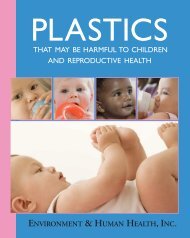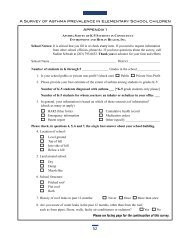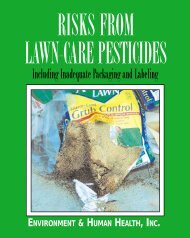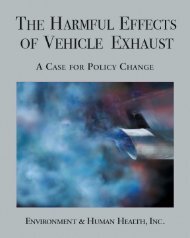LEED Report - Environment & Human Health, Inc.
LEED Report - Environment & Human Health, Inc.
LEED Report - Environment & Human Health, Inc.
- No tags were found...
Create successful ePaper yourself
Turn your PDF publications into a flip-book with our unique Google optimized e-Paper software.
The Green Building DebateEPA has understood the extent of pesticide contamination of drinkingwater supplies for decades, but has neglected to regulate chemical use,or to warn consumers about effective filtration technologies.PlasticsNo law in the United States requires labeling of chemical ingredientsin plastics, and their use is not restricted in <strong>LEED</strong>-certified buildings.Plastics now comprise nearly 70 percent of the synthetic chemicalindustry in the U.S., where each year more than 100 billion poundsof resins are formed into build ing materials, window and doorcasings, furnishings, electrical wiring, piping, insulation, water andwaste conduits, floor coverings, wood sealants, wallpaper, paints,packaging materials, appliances, countertops, lighting fixtures andelectronics.The chemical contents of plastics have always been a mystery toconsumers. Ingredients are not labeled under federal law, and mostmanufacturers are unwilling or unable to disclose these contents ortheir sources. Some products are labeled to facilitate recycling but notto identify chemicals used in their manufac ture.Other chemicals may leachinto water after travelingthrough plastic pipes.... Nolaw in the United Statesrequires labeling of thechemical ingredients inplastics, and their use isnot restricted in <strong>LEED</strong>certifiedbuildings.There are many chemicals used to manufacture plastics, some of whichare harmless and others toxic. Several well-researched compounds mayharm human health and the environment, including bisphenol-A (BPA),polyvinyl chloride (PVC), phthalates, perfluorooctanoic acid (PFOA) orchemicals in the rubber infill in artificial turf. Use of these chemicals inbuilding materials is not restricted by <strong>LEED</strong>, nor are credits awarded foravoiding these products.B i s p h e n o l - A ( B PA )Each year several billion pounds of BPA are produced in the U.S. TheCenters for Disease Control and Prevention (CDC) found that over 9029







